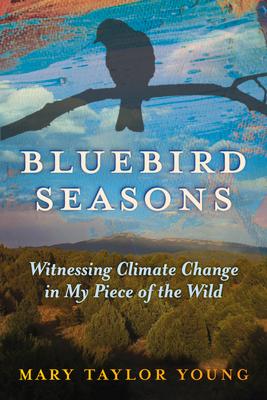
Book
Bluebird Seasons: Witnessing Climate Change in My Piece of the Wild
(Write a Review)
Paperback
$18.99
In this A Sand County Almanac for the twenty-first century, nature writer and zoologist Mary Taylor Young tells the story of the growing effects of climate change on her land in the pine-covered foothills of southern Colorado. Climate change wasn't yet on the public radar when Young and her husband bought their piece of the wild in 1995. They built a cabin, set up a trail of bluebird nest boxes, and began a nature journal of observations, delighting in the ceaseless dramas, joys, and tragedies that are the fabric of life in the wild. But changes greater than the seasonal cycles of nature became evident over time: increasing drought, wildfires, bears delaying hibernation, and the decline of familiar birds and appearance of new species. Their journal of sightings over twenty-five bluebird seasons, she realized, was a record of climate change happening, not in an Indonesian rainforest or on an Antarctic ice sheet but in their own natural neighborhood. Using the journal as a chronicle of change, Young tells a story echoed in everyone's lives and backyards. But it's not time to despair, she writes. It's time to act. Young sees hope in the human ability to overcome great obstacles, in the energy and determination of young people, and in nature's resilience, which the bluebirds show season after season.
In this A Sand County Almanac for the twenty-first century, nature writer and zoologist Mary Taylor Young tells the story of the growing effects of climate change on her land in the pine-covered foothills of southern Colorado. Climate change wasn't yet on the public radar when Young and her husband bought their piece of the wild in 1995. They built a cabin, set up a trail of bluebird nest boxes, and began a nature journal of observations, delighting in the ceaseless dramas, joys, and tragedies that are the fabric of life in the wild. But changes greater than the seasonal cycles of nature became evident over time: increasing drought, wildfires, bears delaying hibernation, and the decline of familiar birds and appearance of new species. Their journal of sightings over twenty-five bluebird seasons, she realized, was a record of climate change happening, not in an Indonesian rainforest or on an Antarctic ice sheet but in their own natural neighborhood. Using the journal as a chronicle of change, Young tells a story echoed in everyone's lives and backyards. But it's not time to despair, she writes. It's time to act. Young sees hope in the human ability to overcome great obstacles, in the energy and determination of young people, and in nature's resilience, which the bluebirds show season after season.
Paperback
$18.99